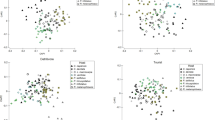Abstract
Australia’s modest tropical rainforest resources have been recognised both by measures taken to conserve them in recent years and by the establishment of a major Cooperative Research Centre to investigate their biodiversity and dynamics to underpin proper management as well as to generate biological understanding. Investigations of the arthropod biodiversity of the canopy strata have been underway for several years. Over the last two years the focus of this work has moved to include sites in the lowland forests of Cape Tribulation. These canopy studies take a ‘top-down’ approach to biodiversity definition generating, in sequence, ordinal, familial and specific profiles as well as guild structures for particular sites, samples or target trees. Recent work, following earlier hypotheses of Terry Erwin, has included investigations of the tree-species specificity of arthropod assemblages focussing in particular on the Coleoptera. Early results of these studies are presented, in particular relating to the canopy faunas of the very local endemic tree Noahdendron nicholasii and the more widespread Ryparosa javanicum. Difficulties associated with sampling, analysis and the identification of specificity at the level of the assemblage are discussed. Other work in progress and extension of the tree-specificity work under the aegis of the newly proposed Tropical Rainforest Research Centre is foreshadowed.
Access this chapter
Tax calculation will be finalised at checkout
Purchases are for personal use only
Preview
Unable to display preview. Download preview PDF.
Similar content being viewed by others
Literature Cited
ERWIN, T. L. 1982. Tropical forests: their richness in Coleoptera and other species. Coleopterists’ Bulletin 36:74–75.
ERWIN, T. L. 1983. Beetles and other arthropods of the tropical forest canopies at Manaos, Brasil, sampled with insecticidal fogging techniques. Pp. 59–75. in Sutton, S.L., Whitmore, T.C. & Chadwick, A.C. (eds). Tropical Rain Forests: Ecology and Management. Blackwell Scientific Publications, Oxford.
ERWIN, T. L. 1991. How many species are there?: revisited. Conservation Biology 5:330–333.
GASTON, K. J. 1991. The magnitude of global insect species richness. Conservation Biology 5:283–296.
HODKINSON, I. D. & CASSON, D. 1991. A lesser predilection for bugs: Hemiptera (Insecta) diversity in tropical rain forests. Biological Journal of the Linnean Society 43:101–109.
JESSUP, L. W. & GUYMER, G. P. 1985. Vascular plants recorded from the Cape Tribulation area. Queensland Naturalist 26:2–19.
MAY, R. M. 1988. How many species are there on Earth? Science 241:1441–1449.
MAY, R. M. 1990. How many species? Philosophical Transactions of the Royal Society of London B330:293–304.
KITCHING, R. L. 1992. Biodiversity, research and conservation in Australian rainforests. Malayan Nature Journal 45:31–54.
KITCHING, R. L., BERGELSON, J. M., LOWMAN, M. D., MCINTYRE, S. & CARRUTHERS, G., in press. The biodiversity of arthropods from Australian rain forest canopies: general introduction, methods, sites and ordinal results. Australian Journal of Ecology 18.
KITCHING, R. L. & ARTHUR, M. 1993. The biodiversity of arthropods from Australian rain forest canopies: summary and the impact of drought. Selbyana 14:29–35.
MCINTYRE, S., KITCHING, R. L. & JESSUP, L. W., in press. Structure and composition of rain forest plots at Cape Tribulation, Queensland. Proceedings of the Royal Society of Queensland.
MCKENZIE, F. 1985. Climbing plants from ‘Pilgrim Sands’, Cape Tribulation. Queensland Naturalist 26:20–25.
SOLOW, A. R. 1993. A simple test for change in community structure. Journal of Animal Ecology 62:191–193.
STORK, N. E. 1987a. Guild structure of arthropods from Bornean rain forest trees. Ecological Entomology 12:69–80.
STORK, N. E. 1987b. Arthropod faunal similarity of Bornean rain forest trees. Ecological Entomology 12:219–226.
STORK, N. E. 1988. Insect diversity: facts, fiction and speculation. Biological Journal of the Linnean Society 35:321–337.
STORK, N. E. & BRENDELL, M. J. D., in press. Arthropod diversity studies in lowland rain forest of Seram, Indonesia. In Proctor, J. & Edwards, I. (eds). The Natural History of Seram.
TRACEY, J. G. 1982. The Vegetation of the Humid Tropical Region of North Queensland. CSIRO Division of Plant Industry, Melbourne.
WEBB, L. J. 1959. A physiognomic classification of Australian rain forests. Journal of Ecology 47:551–570.
WEBB, L. J., TRACEY, J. G. & WILLIAMS, W. T. 1976. The value of structural features in tropical forest typology. Australian Journal of Ecology 1:3–28.
Author information
Authors and Affiliations
Editor information
Editors and Affiliations
Rights and permissions
Copyright information
© 1996 Kluwer Academic Publishers
About this chapter
Cite this chapter
Kitching, R.L., Zalucki, J. (1996). The biodiversity of arthropods from Australian rain forest canopies: some results on the role of the tree species. In: Edwards, D.S., Booth, W.E., Choy, S.C. (eds) Tropical Rainforest Research — Current Issues. Monographiae Biologicae, vol 74. Springer, Dordrecht. https://doi.org/10.1007/978-94-009-1685-2_2
Download citation
DOI: https://doi.org/10.1007/978-94-009-1685-2_2
Publisher Name: Springer, Dordrecht
Print ISBN: 978-94-010-7255-7
Online ISBN: 978-94-009-1685-2
eBook Packages: Springer Book Archive




